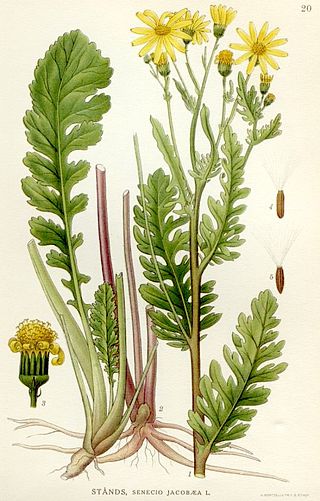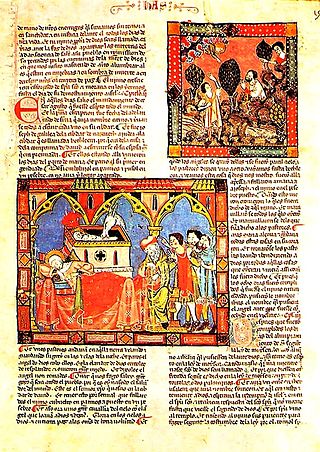
Cinnabar, or cinnabarite, is the bright scarlet to brick-red form of mercury(II) sulfide (HgS). It is the most common source ore for refining elemental mercury and is the historic source for the brilliant red or scarlet pigment termed vermilion and associated red mercury pigments.

Jacobaea vulgaris, syn. Senecio jacobaea, is a very common wild flower in the family Asteraceae that is native to northern Eurasia, usually in dry, open places, and has also been widely distributed as a weed elsewhere.

XXXX is a brand of Australian beer brewed in Milton, Brisbane, by Queensland brewers Castlemaine Perkins. It enjoys wide popularity in the state of Queensland, where it is commonly found on-tap in pubs and bars.

John Bright was a British Radical and Liberal statesman, one of the greatest orators of his generation and a promoter of free trade policies.

Vermilion is a color family and pigment most often used between antiquity and the 19th century from the powdered mineral cinnabar. It is synonymous with red orange, which often takes a modern form, but is 11% brighter.

The Arctiinae are a large and diverse subfamily of moths with around 11,000 species found all over the world, including 6,000 neotropical species. This subfamily includes the groups commonly known as tiger moths, which usually have bright colours, footmen, which are usually much drabber, lichen moths, and wasp moths. Many species have "hairy" caterpillars that are popularly known as woolly bears or woolly worms. The scientific name Arctiinae refers to this hairiness. Some species within the Arctiinae have the word "tussock"' in their common names because they have been misidentified as members of the Lymantriinae subfamily based on the characteristics of the larvae.

The cinnabar moth is a brightly coloured arctiid moth found as a native species in Europe and western and central Asia then east across the Palearctic to Siberia to China. It has been introduced into New Zealand, Australia and North America to control ragwort, on which its larvae feed. The moth is named after the red mineral cinnabar because of the red patches on its predominantly black wings. The species was first described by Carl Linnaeus in his 1758 10th edition of Systema Naturae. Cinnabar moths are about 20 mm (0.79 in) long and have a wingspan of 32–42 mm (1.3–1.7 in).
Saint John's or St. John's may refer to:
Lyric Theatre or Lyric Theater may refer to:
Red mercury is a hoax substance of uncertain composition purportedly used in the creation of nuclear bombs.

Varieties of the color red may differ in hue, chroma or lightness, or in two or three of these qualities. Variations in value are also called tints and shades, a tint being a red or other hue mixed with white, a shade being mixed with black. A large selection of these various colors are shown below.

Eublemma anachoresis, the banner, is a moth of the family Erebidae. The species was first described by Hans Daniel Johan Wallengren in 1863. It is found in the Indomalayan realm, Australia and the southern part of Africa. Records include Fiji, Hong Kong, India, Sri Lanka, Japan, the Society Islands, Eswatini, Taiwan, Thailand and northern New South Wales and Queensland in Australia.
Majestic Theatre or Majestic Theater may refer to:

Parepisparis lutosaria, the bright twisted moth, is a species of moth of the family Geometridae first described by Rudolf Felder and Alois Friedrich Rogenhofer in 1875. It is known from the Australian states of Queensland, New South Wales and Victoria.

Minium, also known as red lead or red lead oxide, is a bright orange red pigment that was widely used in the Middle Ages for the decoration of manuscripts and for painting. Often mistaken for less poisonous cinnabar and vermillion, minium was one of the earliest pigments artificially prepared and is still in use today. It was made by roasting white lead pigment in the air; the white lead would gradually turn yellow, then into an orange lead tetroxide. Minium's color varied depending upon how long the mineral was roasted.
The Cinnabar Theater, located in Petaluma, California, is a professional non-profit theater producing opera and musical theatre, drama and a chamber music series in a 120-seat venue, under the auspices of the Cinnabar Arts Corporation. The venue is also home to the Young Repertory Theater, the longest running and largest youth performing arts program in Sonoma County. The company's Music Director is Mary Chun.
Mary Chun is an American conductor based in the San Francisco Bay Area. She is Music Director of the Cinnabar Theater and has been the conductor of Earplay since 2000.

Cinnabar is a rural locality in the Gympie Region, Queensland, Australia. In the 2016 census, Cinnabar had a population of 72 people.

Kinbombi is a rural town and locality in the Gympie Region, Queensland, Australia. In the 2016 census, the locality of Kinbombi had a population of 37 people.
Black Snake is a rural locality in the Gympie Region, Queensland, Australia. In the 2021 census, Black Snake had a population of 88 people.











